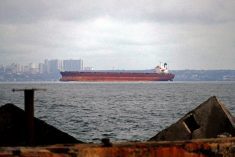Shipping is up through the St. Lawrence Seaway — but grain isn’t contributing to that volume.
General cargo shipments through the St. Lawrence Seaway were up about 70 per cent from the same period last year, the Chamber of Marine Commerce said in a mid-December report.
That figure includes steel, aluminum, oversized machinery and other general shipments between March 22 and November 30.
Read Also

Manitoba Ag Days 2026: Local businesses gear up for Brandon farm show
Most of agriculture is seemingly at Manitoba Ag Days each January: Manitoba agribusinesses and farm groups look forward to connecting with farmers at the 2026 show.
Iron ore shipments were up 17 per cent in the same period, while dry bulk shipments like stone, cement and gypsum had increased six per cent, the Chamber of Marine Commerce news release said.
Overall, cargo shipments via the seaway between March 22 and November 30 totalled 33.3 million metric tons, a rise of nearly two per cent from 2020. Slower grain exports due to smaller harvests compared to 2020 continue to offset the growth in other cargo sectors. Without grain factored in, overall tonnage numbers would be up 13 per cent.
Iron ore and steel shipments surpassed pre-pandemic levels, the news release said.
“The 2021 season has been an impressive story of recovery and growth in some of our key markets,” said Terence Bowles, president and CEO of the St. Lawrence Seaway Management Corporation in the news release.
December is a critical month for the waterway, he added. Manufacturers stockpile raw materials, and grain and potash exporters get final products to market before the seaway closes for winter.
The Montreal-Lake Ontario section of the seaway was scheduled to close to ship traffic December 31, while the Welland Canal will remain open until January 7 to facilitate domestic shipping between Lake Ontario and the Upper Lakes.
At the Port of Thunder Bay, ships arriving in December will be loading grain and potash for export to Europe.
Potash shipments are up more than 200,000 metric tons, or 70 per cent, over 2020 volumes. “Exporters are taking advantage of the seaway, particularly given the disruption on the West Coast,” said Tim Heney, CEO for the Thunder Bay Port Authority, in the release. Thunder Bay is the only potash export port on the Great Lakes-St. Lawrence Seaway, he added.
While grain shipments have been down this season, general cargo shipments at Thunder Bay are up 92 per cent. In November, ships delivered dimensional cargoes including gas turbines and reactors headed for Western Canada.
Grain volumes at the Port of Windsor are also slightly down after record volumes in 2020, but still above average. The big news at the port continues to be construction-related materials – with year-to-date aggregates up 12 per cent and steel 167 per cent.
“There is a huge change in demand for steel. We had two ships delivering steel in 2020 and 12 ships this year — it really speaks to the recovery of the Canadian economy,” said Steve Salmons, president and CEO of Windsor Port Authority.
Hamilton port’s year-to-date total of 9.5 million metric tons is 16 per cent higher than the same period in 2020. Its year-to-date total has now exceeded 2019, pre-pandemic totals by this point in the season. Grain, sugar, fertilizer and construction materials have all been highlights so far in Hamilton.
The Port of Oshawa has also seen a significant increase in finished steel.















